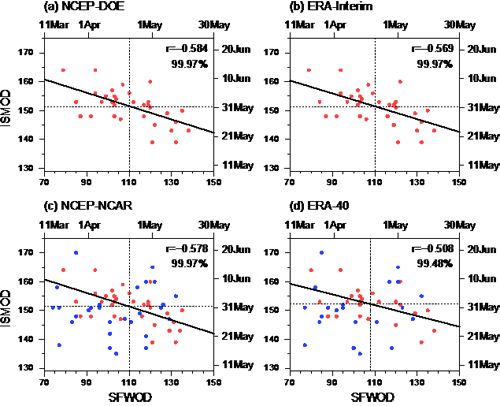The precursor signal in stratosphere is identified to improve ISM onset prediction
Date:2014-12-01
The Indian Summer Monsoon (ISM) is a key branch of the Asian summer monsoon system, being recognized having remarkable influences on the climate anomalies in China. How to understand and predict the ISM onset has long been one of the important problems for the meteorologists. The stratospheric polar warming event in every spring, results in final breakdown of the polar vortex, and marks the seasonal transition from winter to summer in the stratosphere, similarly as the ISM onset in the troposphere.
Dr. REN Rongcai and her student HU Jinggao from Institute of Atmospheric Physics recently reports in IAP recently reports in their published papers on AGU and AMS journals that, a significant relationship between the onset of the ISM and the seasonal timing of the stratospheric final warming(SFW) has appeared in recent decades. Specifically, late/early timing of SFW in stratosphere tends to be followed by early/late onset of the ISM (See Figure 1). Since the stratospheric SFWs occur on average in mid-April, while the onset of ISM is generally from the end of May to the early June, the authors emphasize that the seasonal timing of the SFW in the spring stratosphere acts as an emerging precursor signal for the onset of the ISM. They indicate that, in contrast to the earlier decades before 1970s, the stratosphere-troposphere dynamic coupling in the extratropics during the period from April to early-May, has become much stronger in recent decades, which gives rise to the stronger coupling between the stratospheric SFW and the tropospheric AO (Arctic Oscillation), and is responsible for the emerging SFW-ISM relationship. Their further studies demonstrate that, the timing of the SFW in spring is in turn related to the occurrence of stratospheric sudden warming events in the preceding winter. This further supports that the identified precursor signal in stratosphere has great significance for ISM onset prediction.

Figure 1 Scatterplots of the ISMOD (ordinate) against the SFWOD (abscissa) in (a) NCEP-DOE, (b) ERA-Interim, (c) NCEP/NCAR and (d) ERA-40. Blue points represent the years before 1979, and red points the years after 1979. The solid lines are the linear regression fits of the ISMOD against the SFWOD during 1979–2010. The dashed lines indicate the average dates of ISMOD and SFWOD during 1979–2010.
Reference:
· Ren, Rongai*, Hu, Jinggao 2014: An emerging precursor signal in the stratosphere in recent decades for the Indian summer monsoon onset. Geophys. Res. Lett. 41(20): 7391-7396, DOI: 10.1002/2014GL061633.
· Hu, J. G., Ren, R. C.* and Xu, H. M. 2014: Occurrence of winter stratospheric sudden warming events and the seasonal timing of spring stratospheric final warming. J. Atmos. Sci., 71, 2319-2334, DOI: 10.1175/JAS-D-13-0349.1.
Key words: Precursor signal, Indian summer monsoon onset, Stratosphere
